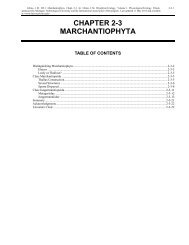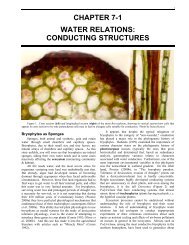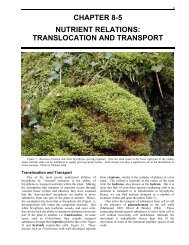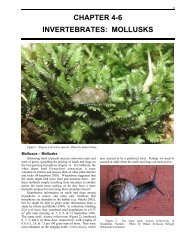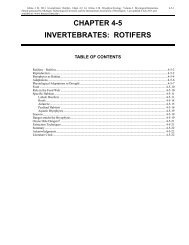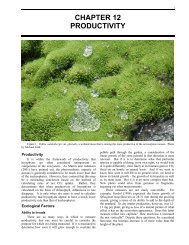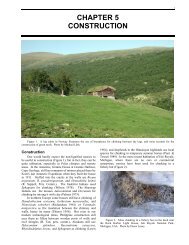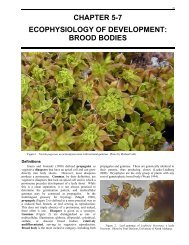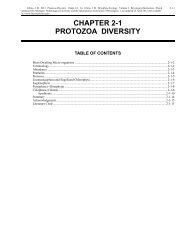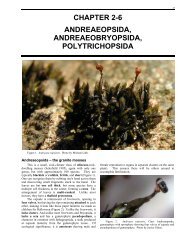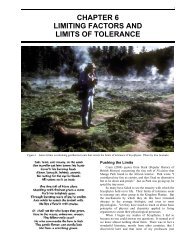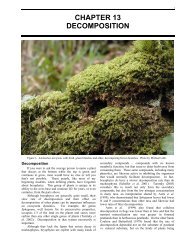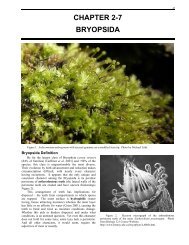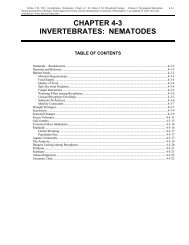chapter 8-3 nutrient relations: nitrogen - Bryophyte Ecology ...
chapter 8-3 nutrient relations: nitrogen - Bryophyte Ecology ...
chapter 8-3 nutrient relations: nitrogen - Bryophyte Ecology ...
You also want an ePaper? Increase the reach of your titles
YUMPU automatically turns print PDFs into web optimized ePapers that Google loves.
24 Chapter 8-3: Nutrient Relations: Nitrogen<br />
Subalpine Coniferous forest floor Feather mosses 0.23 nmol N gdm -1 hr -1<br />
Subalpine Coniferous forest floor Sphagnum 7.47 nmol N gdm -1 hr -1<br />
Alpine zone<br />
of Mt. Fuji<br />
Antarctic<br />
Antarctic<br />
Antarctic<br />
Mountain summit<br />
East Ongul Island,<br />
Antarctica. Sand near a<br />
rocky peak.<br />
Marion Island (highly<br />
minerotrophic receiving<br />
<strong>nutrient</strong>-rich mire runoff)<br />
Marion Island (exposed<br />
wind-swept rocky ridges)<br />
Antarctic Marion Island (submerged)<br />
Antarctic<br />
Fumaroles near summit of<br />
Mt. Melbourne<br />
Aongstroemia fuji-alpina, Ceratodon purpureus,<br />
& Bryum + Nostoc<br />
Ceratodon purpureus & Bryum pseudotriquetrum<br />
+ Nostoc<br />
Brachythecium subplicatum + Anabaena,<br />
Calothrix, Hapalosiphon, Nostoc, Sphaerocystis,<br />
Stigonema, & Tolypothrix<br />
Ditrichum strictum (balls) + Anabaena,<br />
Calothrix, Hapalosiphon, Nostoc, Sphaerocystis,<br />
Stigonema, & Tolypothrix<br />
Grimmia falcate + Anabaena, Calothrix,<br />
Hapalosiphon, Nostoc, Sphaerocystis, Stigonema,<br />
& Tolypothrix<br />
Campylopus pyriformis & Cephaloziella<br />
exiliflora + Mastigocladus laminosus<br />
Peatland Associations<br />
Sphagnum is highly colonized by a variety of<br />
Cyanobacteria, both on its surface (Hooper 1982), and in its<br />
hyaline cells (Figure 16; Granhall & Hofsten 1976;<br />
Granhall & Lindberg 1978), especially by Nostoc and<br />
Hapalosiphon (Sheridan 1975). In bogs and fens,<br />
Cyanobacteria on bryophyte surfaces can contribute<br />
considerable usable N to the ecosystem (Alexander et al.<br />
1974; Basilier et al. 1978, Basilier 1979; Lambert &<br />
Reiners 1979; Rosswall & Granhall 1980, Hooper 1982).<br />
Chapman and Hemond (1982) determined that the<br />
contribution was greater than that from the only other<br />
known input, bulk precipitation (as NO3 - ). Three types of<br />
Sphagnum associations fix N: epiphytic Cyanobacteria,<br />
intracellular Cyanobacteria, and N-fixing bacteria<br />
(Granhall & Selander 1973, Granhall & Hofsten 1976).<br />
Basilier (1979) reported N-fixation activity by<br />
Cyanobacteria on Sphagnum, Drepanocladus, and<br />
Calliergon in phosphorus-rich environments. Basilier and<br />
coworkers (1978), as well as Granhall and Selander (1973),<br />
found that the highest N fixation rates in their studies<br />
occurred on the mosses Sphagnum and Drepanocladus<br />
(s.l.), with a mean value of 9.4 g m -2 yr -1 . In fact,<br />
Cyanobacteria associated with Sphagnum can have higher<br />
N fixation per heterocyst than do free-living Cyanobacteria<br />
in the same condition (Basilier 1980). Granhall and<br />
Lindberg (1978) reported a total rate of 0.8-3.8 g fixed N<br />
m -2 yr -1 in wet Sphagnum communities in a mixed pine and<br />
spruce forest in central Sweden. Zimicki (1976) and<br />
Basilier et al. (1978) have estimated N fixation in various<br />
sites for Sphagnum riparium to be 0.5-6.4 g m -2 yr -1 .<br />
Basilier et al. (1978) found that the fixation rate in the<br />
Sphagnum riparium association was strongly light<br />
dependent, but that pH in the range of 4.3 to 6.8 had little<br />
effect. Maximum fixation occurred around noon with the<br />
middle of the growing season exhibiting the highest rates.<br />
Interestingly, they found that rates on the apical portions<br />
and non-green portions of the Sphagnum were lower, and<br />
that the highest rates occurred on the periphery of the moss<br />
community. On the other hand, using 15 N as a tracer,<br />
Basilier (1980) later found that enrichment of N from<br />
Cyanobacteria fixation appeared within two hours in the<br />
apex of Sphagnum. It appears that habitat comparisons<br />
need to be made to determine where the highest rates might<br />
occur.<br />
3.4 nmol N cm -2 hr -1<br />
2.37 nmol N cm -2 hr -1<br />
Granhall & Lindberg<br />
1978<br />
Granhall & Lindberg<br />
1978<br />
Nakatsubo & Ohtani<br />
1991<br />
Nakatsubo & Ino 1987<br />
103.5 nmol N gdm -1 hr -1 Smith & Russell 1982<br />
0.12 nmol N gdm -1 hr -1 Smith & Russell 1982<br />
5.15 nmol N gdm -1 hr -1 Smith & Russell 1982<br />
11 nmol N gdm -1 d -1 Broady et al. 1987<br />
Figure 16. Potential interactions of micro-organisms within<br />
the hyaline cell of Sphagnum. Redrawn from Granhall & Hofsten<br />
(1976).<br />
Once the Cyanobacteria convert the N to NH4 + and<br />
amino acids, these are available not only for the bryophytes<br />
they occupy, but also for the tracheophytes rooted among<br />
them. In Thoreau's Bog in Massachusetts, N fixation<br />
exceeded atmospheric N deposition (Hemond 1983), and<br />
Hemond concluded that microbial N fixation provides<br />
sufficient quantity of N that N may never be limiting to<br />
primary productivity in a bog (or poor fen) ecosystem.<br />
Liverwort Symbiosis<br />
Several attempts have been made to explain the high<br />
degree of N fixation in liverwort associations. In an early<br />
attempt, Griggs (1937) grew liverworts from Katmai<br />
volcanic ash on N-free sand for three years to determine<br />
their success compared to that of liverworts on the same<br />
medium, but with the addition of 4 mg/L NH4NO3. During<br />
that three-year period, the ones with the additive grew no<br />
better, but toward the end of the three years, the N-free<br />
cultures became pale and unhealthy. When 4 mg/L<br />
NH4NO3 was added to the N-free cultures, they promptly<br />
revived. Griggs took this as evidence that no N fixation<br />
had occurred.<br />
Nevertheless, at least the thallose liverwort Blasia<br />
pusilla has symbiotic Cyanobacteria that do perform N



